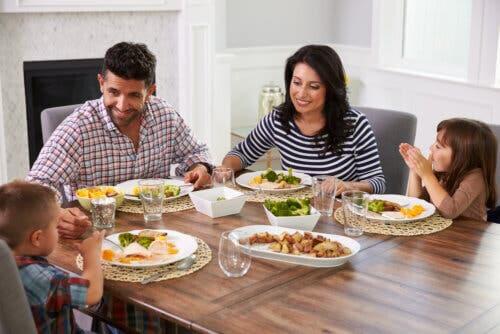Types of Families According to Their Degree of Cohesion

Each family unit is unique. The norms and the way the members relate to one another is different from one family to the next. Therefore, there are numerous types of families, depending on where we place our focus.
One of the most important factors to evaluate when we want to know how a family works is their degree of cohesion. This indicates to what point the members are involved with one another. It also reveals how much they worry about one another and help one another mutually.
At first sight, it may seem like a high degree of cohesion is ideal, because love and support are essential. However, families also need to allow for the freedom and autonomy of each one of their members. Each member should be able to develop individually without the fear of being rejected by his or her family.
So, we can say that the degree of cohesion in a family is a continuum, and it’s best to seek balance and avoid extremes. Family dependence is negative and limiting. But, at the same time, extreme independence is also harmful. Therefore, the healthiest families are those that are situated closer to the middle. They’re interdependent, have better relationships, and great wellbeing.
Types of families according to their degree of cohesion
Disengaged
These families have an extreme level of independence. Their members share little involvement with one another, spend little time together, and interaction is scarce. Rarely do they show one another affection nor do they turn to one another for support or guidance when making decisions.

Each family member has a separate life, maintaining separate spheres and enjoying distinct activities and interests. There is very little emotional connection and loyalty. Independence and individuality prevail above all else.
Separated
These families are closer to the middle of the continuum and are more healthy. Within their family dynamics, there’s a certain level of loyalty and involvement between members, as well as shows of affection. But, there continues to be a strong degree of personal separation and individual development.
Each member has different interests and they tend to spend their leisure time apart from one another. But there are also times when they share the same space and enjoy the same recreational activities. Limits between parents and children are clear, but they still enjoy emotional closeness.
Connected
Connected families are another one of the types of families. Compared to separated families, they enjoy a greater degree of emotional closeness and intimacy but are still within healthy limits. Members value their involvement with one another, and family cohesion is a central point of interest that they all have in common. When it comes to making decisions, the opinions of each member are taken into account.
These families make spending time together and sharing interests and activities a priority. They also respect one another’s personal space and time.
Enmeshed
Lastly, enmeshed families are at the other end of the spectrum. In other words, they display an excessive degree of dependence and attachment. An extreme level of emotional closeness and absolute involvement exists between members. Family is the biggest priority, loyalty is obligatory, and decisions are based on joint interest.

Family members share most of their activities, time, and space and there is barely any room for privacy and personal development. At the same time, there is a lack of limits between parents and children, which can lead to unhealthy alliances. Their individual roles lack a healthy definition.
Satisfaction within different types of families
A healthy family is one where there is a balance between attachment and independence. It’s a family where there is love, support, and trust, but where each member is allowed to have his or her own free will.
It’s up to each family to decide what type of relationships they want to establish with one another. However, it’s important to understand that extreme positions can be harmful both to parents and children.
Families that are excessively independent can produce family members that feel lonely, without affection, support or a sense of belonging. At the same time, families that are overly attached can get in the way of individual freedom and lead to harmful dependency, even in adulthood. Therefore, it’s always best to seek a healthy balance .
All cited sources were thoroughly reviewed by our team to ensure their quality, reliability, currency, and validity. The bibliography of this article was considered reliable and of academic or scientific accuracy.
- Tueros, R. V. (2004). Cohesión y adaptabilidad familiar y su relación con el rendimiento académico.
- Dickinson, M.A., Ponce, E.R., Gómez, F.J., González, E., Fernández, M.A., Corzo, M.TT, Púrez, S., Flores, P. (1998). Determinantes sociales en la cohesión y adaptabilidad familiar. Aten Primaria, 21(5), 275-82.